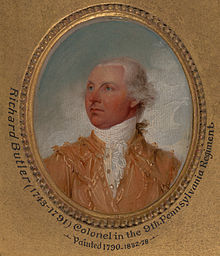Richard Butler (general)
This article needs additional citations for verification. (September 2014) |
Richard Butler | |
|---|---|
 | |
| Born | April 1, 1743 Dublin |
| Died | November 4, 1791 (aged 48) Fort Recovery, Ohio |
| Allegiance | |
| Service | Continental Army United States Army |
| Years of service | 1776-1783, 1791 |
| Rank | Major General |
| Unit | Morgan's Riflemen |
| Battles / wars | Battle of Saratoga; Battle of Monmouth; St. Clair's Defeat |
| Awards | Society of the Cincinnati |
Richard Butler (April 1, 1743 – November 4, 1791) was an officer in the Continental Army in the American Revolutionary War, who later died fighting Indians in Ohio.
Early life
Born in St. Bridget's Parish, Dublin, Ireland, Richard Butler was the oldest son of Thomas and Eleanor (Parker) Butler. Thomas Butler was an Irish aristocrat who served in the British army. In 1748 he opened a gun shop in Dublin, but that same year the family moved to Lancaster, Pennsylvania, where Thomas learned to make the Pennsylvania long rifles used in the French and Indian War.
By 1760, the family had moved to the frontier at Carlisle, Pennsylvania, where Thomas and his sons manufactured long rifles and became friends with Daniel Morgan. The Butler gun shop still stands in Carlisle.
By the 1770s, Richard Butler and his brother William were important traders at Fort Pitt in Pennsylvania and in Ohio. A street in Pittsburgh, Butler Street, is named for them.
American Revolution
At the outset of the American Revolution, the Continental Congress named Richard Butler a commissioner in 1775 to negotiate with the Indians. He visited representatives of the Delaware, Shawnee, and other tribes to secure their support, or at least neutrality, in the war with Britain.
In 1776, Butler was commissioned a major in the Continental Army, serving first as second in command to his friend Daniel Morgan. He saw action at the Battle of Saratoga and the Battle of Monmouth. His four brothers also served, and were noted for their bravery as the "fighting Butlers."
In 1781, Butler lead the Continental Army at the Battle of Spencer's Ordinary.
At Yorktown, George Washington conferred on Richard Butler the honor of receiving Cornwallis' sword of surrender, an honor which Richard gave to his second in command, Ebenezer Denny. At the last moment, Baron von Steuben demanded that he receive the sword. This almost precipitated a duel between Butler and Von Steuben.
At the victory dinner for his officers, George Washington raised his glass and toasted, "The Butlers and their five sons!"
Butler was an original member of the Society of the Cincinnati.
Post American Revolution activity
After the war, the Confederation Congress put Richard Butler in charge of Indians of the Northwest Territory. He negotiated the Treaty of Fort Stanwix in 1784, in which the Iroquois surrendered their lands. He was also called upon during later negotiations, such as the Treaty of Fort McIntosh in 1785.
Butler returned to Pennsylvania, and was a judge in Allegheny County. He also served in the state legislature. He married Maria Smith[1] and had four children, only one who lived to have children and continue his line. Butler also fathered a son, Captain Butler (or Tamanatha) with Shawnee chief Nonhelema. Butler and his Shawnee son fought in opposing armies in 1791.[2]
He was killed November 4, 1791 at St. Clair's Defeat at what is now Fort Recovery, Ohio. Reportedly he was first buried on the battlefield, which site was then lost until it was accidentally found years later. The remains were laid to rest with the other remains of the fallen at Fort Recovery, Ohio.
Legacy
Butler County, Ohio, where Fort Hamilton stood, is named for Richard Butler, as are Butler County, Kentucky,[3] and Butler County, Pennsylvania. The city of Butler, Pennsylvania and the General Richard Butler Bridge (located in the city of Butler) are also named for him.
A miniature portrait of Richard Butler was painted by "The Painter of The Revolution," Colonel John Trumbull, in 1790 and is in the collection of Yale University.[4]
He is also honored in the name of a chapter of the Daughters of the American Revolution (DAR), the General Richard Butler Chapter, founded in Butler, Pennsylvania.[5]
Notes
- ^ Blount, Jim (12 March 1989). "The Butler We're Named For, Gen. Richard Butler". Hamilton Journal-News. Hamilton, OH. Retrieved 09 Nov 2010.
{{cite news}}: Check date values in:|accessdate=(help) - ^ Winkler, John F (2011). Wabash 1791. St. Clair's defeat. Oxford, UK: Osprey Publishing. p. 19. ISBN 978-1-84908-676-9.
- ^ The Register of the Kentucky State Historical Society, Volume 1. Kentucky State Historical Society. 1903. p. 34.
- ^ Yale University (1892). A catalogue, with descriptive notices, of the portraits, busts, etc., belonging to Yale University. New Haven CT: Press of Tuttle, Morehouse & Taylor. pp. 16–17.
- ^ Website of General Richard Butler Chapter, DAR. http://www.rootsweb.ancestry.com/~pagrbdar/index.html
References
- Chichester, Henry Manners (1886). . In Stephen, Leslie (ed.). Dictionary of National Biography. Vol. 8. London: Smith, Elder & Co.
- Francis Samuel Drake, ed. (1879). "Butler, Richard". Dictionary of American Biography. Houghton; Osgood. pp. 149–150.
